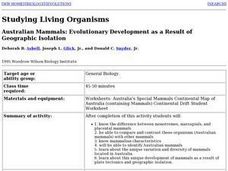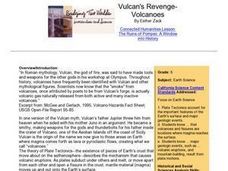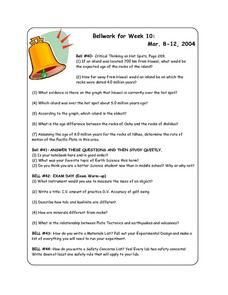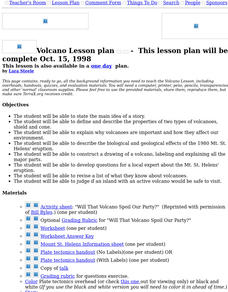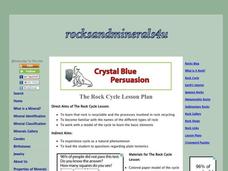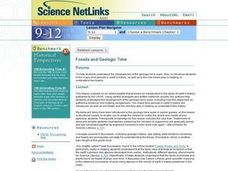Curated OER
Structure of Earth
Seventh graders study and make a model of the significant formations of the ocean floor. They examine images and illustration and apply their imagination while creating the model. They are challenged to complete further research as an...
Curated OER
Hey, I've Got A Question!
Seventh graders explore the Solar System. They develop a research question and use inquiry-based research skills to find the answers to their questions. Students write up their findings and create a multimedia presentation.
Curated OER
Australian Mammals: Evolultionary Development as a Result of Geographic Isolation
Learners examine the differences between monotremes, marsupials, and placental mammals and are able to contrast these organisms with other mammals. They learn about unique variation and the diversity of mammals located in Australia.
Curated OER
The Physical Geography of Australia, Oceania, and Antarctica
Students access information from the United States Geological Survey's Web site This Dynamic Earth to research the Ring of Fire. They answer four questions and then apply what they have learned to create a bulletin board display.
Curated OER
Earthquakes
Students observe the melting of ice. In this phase change lesson, students observe ice as it melts. They discuss the process and create a Venn diagram comparing water and ice.
Curated OER
The Galapagos Islands
In this The Galapagos Islands activity, students read a 1 page article, answer 3 statements with multiple choice answers, fill in 4 fill in the blank answers and 3 determine if 3 statements are true or false.
Curated OER
Vulcan's Revenge-Volcanoes
Sixth graders research various types of volcanoes. They explore the various emissions that come from them. Offer some explanation why some erupt by "quietly" puring lava, while others blast out chunks of rock and clouds of ash and gases.
Curated OER
Bellwork for Week 10
In this bellwork worksheet, students answer questions about the Hawaiian islands formation, about science class in general, about rocks and minerals and about experimental design.
Curated OER
The Science Behind Tsunamis
Natural disasters can be teachable moments that create more scientifically literate citizens.
Curated OER
Volcano Lesson Plan
Students describe the properties of volcanoes, and explain why volcanoes are important to the environment.
Curated OER
Volcanoes And Atmospheres
High schoolers identify the volcano as the primary source of atmospheric gases, to explain the formation of ozone, and to recognize the dangers of volcanic gases through the use of technology in the classroom.
Curated OER
Earth: The Water Planet
Students elicit data on the water cycle, ocean topography, and island formation in this six lesson unit. The ocean floor and the properties of water are examined through a variety of discussions and hands-on experiments.
Curated OER
Mount St. Helens Shakes and Burps
Students uncover the nature of volcanoes and locate some of the world's active, dormant, and extinct volcanoes. They also discover how scientists detect, measure, and predict volcanic activity.
Curated OER
The Rock Cycle
Learners study the rock cycle of different types of rock. They arrange cut-outs of the parts of the rock cycle in the correct order and then draw the rock cycle or research different types of rocks.
Curated OER
Science NetLinks: Fossils and Geologic Time
Students investigate the development of the geologic time scale. Also, to introduce them to the major time periods in earth's history, as well as to the role fossils play in helping us understand this history.
Curated OER
Fossils and Geologic Time
Students explore the development of the geologic time scale. They examine the major time periods in earth's history. Students discuss the role fossils play in helping us understand history.
Curated OER
The Basics of Earth Science
Students discuss and define the term "scientific theory." They work in small groups to draft an overview of one theory including details about the theory's evidence and significance.
Curated OER
Geology Word List
In this science worksheet, students review the vocabulary words for the separate categories related to the concept of geology.
Curated OER
A Crust Full of Rocks
In this rock worksheet, students answer seven short answer questions about the composition of the earth's crust. Questions refer to metamorphic, igneous, and sedimentary rocks.
Curated OER
Plotting Earthquakes
In this earthquakes worksheet, students access a website to gather information about the magnitude and location of earthquakes for 5 days. Then students complete 7 short answer questions.
Curated OER
Geological Forces and Topography
Young scholars discuss and research the Earth's geological processes. In this geology lesson, students study maps of Utah and the United States to learn about geological features. Young scholars then complete the research cards for each...
Curated OER
Magnetometer Extension Activities
Learners observe magnetic fields and locate the position of "ore deposits" patterns using models and maps. In this magnetometer lesson students complete a hands on activity and a reading/writing exercise.
Curated OER
When a Map Isn't A Map...
In this maps worksheet, students read about the Earth, sky, rivers and lakes, and more, and then answer short answer questions about it. Students complete 3 questions.
Curated OER
Amazing Planet DVD-Video Assignment
In this geography skills learning exercise, students watch the National Geographic video "Amazing Planet." Students then respond to 13 short answer questions about the content of the video.
Other popular searches
- Map of Tectonic Plates
- Floating Tectonic Plates
- Geography Tectonic Plates
- Pacific Basin Tectonic Plates
- Movement of Tectonic Plates
- Tectonic Plates Converge
- Tectonic Plates Move Apart
- Tectonic Plates Oranges
- Edible Tectonic Plates
- Tectonic Plates and Volcanoes




